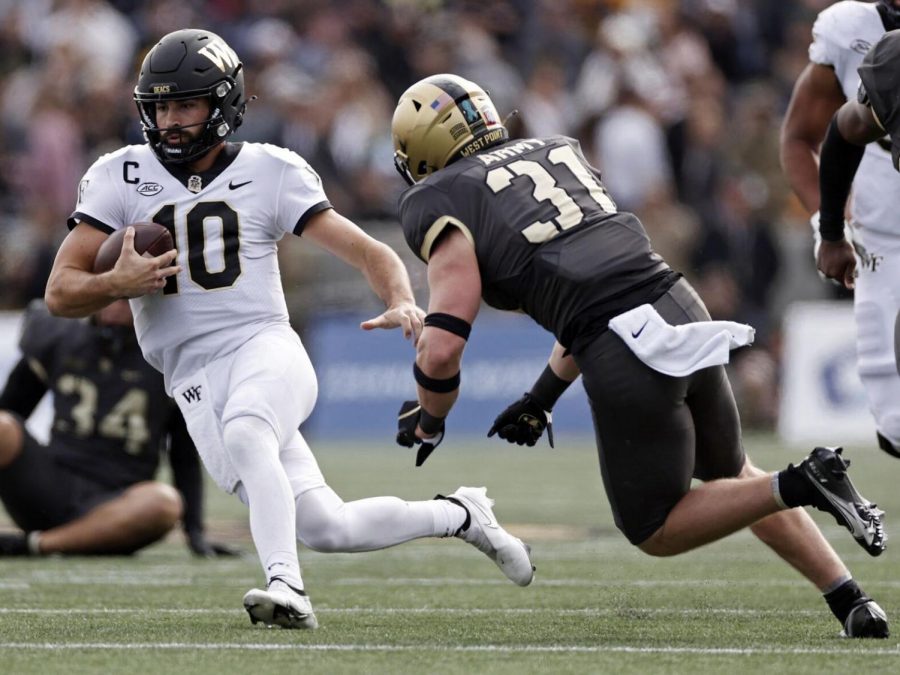NIL signals the end of the NCAA’s purpose
The myth of amateurism in college athletics propagates NCAA’s existence
November 4, 2021
Like the ponytail that’s been growing since your barber closed shop back in March of last year, it’s time to cut off the NCAA. Those people who hold their glance a few seconds too long when walking past you on the street? Those aren’t stares of admiration – the time has come and gone.
The original intentions of the NCAA — founded in 1906 as the Intercollegiate Athletic Association — were noble enough. At the turn of the century, collegiate athletics were a bit like the Wild West. Back then, competition and eligibility rules differed from school to school, and there was no governing body ensuring that student-athletes were being treated properly — much less fairly. The playing field was anything but level.
The NCAA intended to order the chaos. As the years went by, though, the landscape changed; as a result, the organization gradually expanded its presence and jurisdiction to meet novel challenges. In doing so, the power and money of collegiate athletics became more and more concentrated in the hands of a few. And those hands have quite the grip.
Over the last 115 years, the NCAA took it upon itself to organize tournaments and championships, sign broadcasting agreements for radio and later television, and codify rules and systems – such as drug-testing programs – to ensure fair play between all member institutions. (except for Notre Dame football … )
That’s all well and good — mutually beneficial, one might even say.
But what’s isn’t mutually beneficial?
The notion of amateurism: the truth of the matter is today’s student-athletes are expected to spend as much time on the field – and out of the classroom – as the professionals are; the one-size-fits-all approach regarding eligibility and financial aid (among other standards): it may have been prudent back in 1906, but is wholly inefficient today given the more than 450,000 students at 1,200 schools in three divisions the organization oversees.
The sentiment that the NCAA serves the best interest of the student-athletes is a cockamamie one. If the students were the priority, there’d be measures assuring their health and safety — both physical and mental — were being properly addressed during their collegiate careers and after it ends, too; there’d be programs preparing the 99% who won’t go to the pros for life after the final whistle; there’d be systems in place to compensate these workers (because let’s call them what they are) for the work they’re doing.
But wait, you say — that system is here!
With the recent rule changes that went into effect on July 1, 2021, regarding name, image and likeness (NIL), the NCAA has unequivocally outlived its purpose.
Even before the Supreme Court’s 9-0 ruling in the NCAA v. Alston case — which stated that the NCAA rules limiting the educational-related benefits institutions could provide to their student-athletes violated anti-trust laws — the strangle-hold was already weakening.
With the door now open to NIL activity (but policy specifics left up to the discretion of individual universities) the ability of the NCAA to enforce and regulate the structure it was originally intended to uphold has been dampened beyond repair.
Universities will champion the demise of the NCAA — it’s inevitable. In fact, it’s already happening. Just this year, Texas and Oklahoma bid farewell to the Big-12 and formally joined the SEC — in respect to the idea of the ‘Superconference’ it’s no longer a question of ‘if,’ but of ‘when’ — and college football’s re-alignment wheel shows no signs of slowing down anytime soon.
You don’t have to be a detective to figure out why — it all comes down to money. It always has. Yes. Always.
Consider this: In 2019, the NCAA generated over $1 billion in revenue — primarily from broadcasting rights for the College Football Playoffs and March Madness. That seems like a lot of money until you see that, in that same year, the NCAA’s member intuitions reported almost $19 billion in total revenue.
The NCAA is a relic of the past. If it wasn’t, the commissioners who represent the five biggest conferences in college athletics wouldn’t have penned a letter to Congress in 2020 imploring a federal ruling to regulate NIL-related endorsements.
“Time is of the essence,” the letter reads. That’s an understatement though because, for the NCAA, time is running out.













